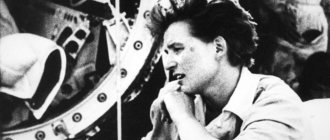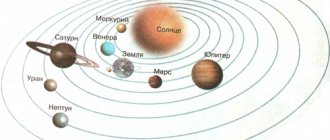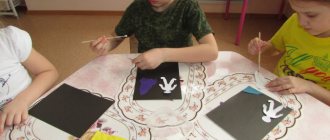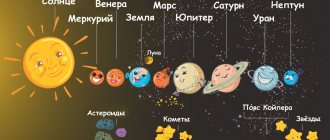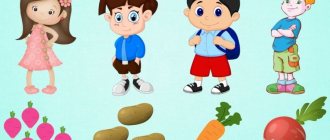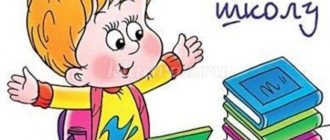Presentation “Journey into Space”
- May 22, 2012
Competition "Presentation Master - 2012"
Nomination "Presentation in the pedagogical process in preschool educational institutions"
To digest knowledge well, you need to absorb it with appetite.
A. France
The use of various methods of transmitting information in the classroom, including information and multimedia technologies, makes it possible to effectively carry out work on the cognitive development of preschool children and to take a creative approach to the process of solving the problems of teaching and upbringing.
The presentation “Journey into Space” was developed as part of a project for senior preschool age on the cognitive development of children “Me and the world around me,” of which I am the author. It was used in a travel lesson (educational area “Cognition, familiarization with the world around us”) (Appendix 2 Lesson notes) which made it possible to solve a number of problems:
- expanding children's knowledge about space, space objects, acquaintance with the history of space exploration, with the fact that the first cosmonaut in the world was a citizen of our country, Yuri Alekseevich Gagarin, who made his flight on April 12, 1967;
- development of memory, attention, imagination, fantasy, aesthetic perception;
- nurturing patriotic feelings, cognitive interest, and the desire to display one’s impressions in drawings.
This presentation made it possible to focus children’s attention on the space objects being studied and to interest them. The result of the lesson using this presentation was the cognitive and creative activity of the students. On the children's initiative, involving parents, we organized a role-playing game for children "Space Travelers" in the group, created a corner "Space", prepared a folder of consultations for parents, and held an exhibition of children's creative works on this topic.
This material can be used as a basis for classes, quizzes and other events on space topics (senior preschool and primary school age). By rearranging slides, adding and removing effects, video and audio fragments, the presentation is customized to the tasks of each specific teacher.
Application: Presentation.
Author: Polina Vladimirovna Sinenko, teacher of the 1st qualification category of MBDOU No. 81 Child Development Center - Kindergarten "Little Little Humpbacked Horse", Norilsk. In my teaching activities, I pay special attention to the cognitive development of children and broadening their horizons.
Presentation for the lesson (preparatory group) on the topic: Presentation on the topic “Space” - presentation
PRESENTATION Topic: Space
The miracle bird, scarlet tail, flew into a flock of stars.
He is not a pilot, not a pilot, He is not flying a plane, But a huge rocket. Children, who, tell me, is this?
For thousands of years people walked the Earth, but could not see it all at once. On November 4, 1957, our country opened a new space era to the world. On this day the first artificial Earth satellite was launched. It weighed 83.6 kilograms and was shaped like a ball with a diameter of 58 centimeters. Now, although not with their own eyes, but with the help of equipment, people were able to see their planet from space.
On the second artificial satellite, the dog Laika was launched into space and circled the Earth.
On April 12, 1961, the planet was shocked by unexpected news: “Man in space! Russian, Soviet! The centuries-old dream of people about flying to the stars has come true. On a sunny morning, a powerful rocket launched the Vostok spacecraft into orbit with Earth's first cosmonaut Yuri Gagarin on board.
Yuri Gagarin took a seat in the cockpit, the command “Start!” was sounded. "Go!" The voice of the first cosmonaut was heard in the radio horns. The engines roared, the rocket took off from the Earth and went into the sky. Such a miracle has never happened A man is rushing into cold space! The name Gagarin, Yuri Gagarin, has entered into the memory of people forever. His feat is legendary! The world is grateful to the daredevil, the Motherland is proud of him! O. Vysotskaya
What did Gagarin experience in the ship? What did he see through the portholes? Listen to an excerpt from his memoirs. “When the ship entered orbit, weightlessness appeared. I left the chair and hung between the ceiling and the floor of the cabin. Everything around me became easier. “Earth” asked what I was seeing, and I said that mountain ranges, large rivers, large forests, spots of islands, and the coastal edge of the seas were clearly visible.”
The first manned flight in space lasted more than an hour, namely 108 minutes. During this time, the Vostok ship flew around the entire globe and landed in a precisely specified area.
The ship landed on a plowed field. And then an interesting episode occurred, which Yuri Gagarin later talked about. “When I stepped onto solid ground, I saw a woman and a girl standing next to a spotted calf and watching me with curiosity. I went to them. They headed towards. But the closer they came, the slower their steps became. I was still in a bright orange spacesuit, and its unusual appearance probably frightened them. They have never seen anything like it before..."
The Vostok spacecraft circled the Earth only once. And a modern space station has been in space for many years; this is a real space house in which astronauts live for many months.
People began to create such stations for long flights into space. This is a real “space house”, which is constantly in space and where astronauts work for many months.
At orbital scientific stations, astronauts from different countries conduct research on the Earth and outer space. Sometimes they leave the station and go into outer space.
The “wings” of the space station are solar panels. They “catch” the sun's rays and turn them into electric current. And the current illuminates, heats the station and powers all scientific instruments. The “wings” of the space station are solar panels. They “catch” the sun's rays and turn them into electric current. And the current illuminates, heats the station and powers all scientific instruments.
You already know that our planet has a natural satellite. What is it called? But man was able to create and launch artificial Earth satellites into space. The Russian word satellite has entered all languages of the world. Nowadays there are many artificial satellites constantly in space. Why are they needed?
Communication satellites carry out television transmissions to remote corners of the Earth. Their help is necessary for radio and telephone communications.
MARINE NAVIGATION TV BROADCASTING MOBILE COMMUNICATION
Nowadays, astronauts fly into space quite often, we are already accustomed to it. But when the first astronaut flew into space, people all over the world experienced amazement and delight.
commander of the TPK Soyuz TMA-M, flight engineer of ISS-30/commander of ISS-31, instructor-cosmonaut-tester of the Federal State Budgetary Institution "Research Institute of Cosmonaut Training Center named after Yu.A. Gagarin", Roscosmos, Hero of the Russian Federation, cosmonaut 2nd class, 102- 1st cosmonaut of the Russian Federation, commander of the Soyuz TMA-M spacecraft, flight engineer of the ISS-30/commander of the ISS-31, instructor-cosmonaut-tester of the Federal State Budgetary Institution "Research Institute of Cosmonaut Training Center named after Yu.A. Gagarin", Roscosmos, Hero of the Russian Federation, cosmonaut of the 2nd class, 102nd cosmonaut of the Russian Federation OLEG DMITRIEVICH KONONENKO
THANK YOU FOR YOUR ATTENTION!!!
MAGAZINE Preschooler.RF
Presentation “What is Space” for older and preparatory children.The presentation contains 13 slides. Each slide contains a brief description of the planets, poems and riddles. Slide 1 – contains the title of the presentation “What is Space” . Slide 2 – a poem about space. Slide 3 - “Sun” - the only star in the solar system is the Sun. The sun is the source of life on Earth. The only star in the solar system is the sun. If you look at the sky, the Sun appears flat and small. But in fact, it is a huge fireball consisting of hot gases. The sun is very hot, and its surface is gases. The Sun is many times larger than the Earth - if you imagine the Earth in the form of a grain, then the Sun next to it will be the size of a watermelon. It is 109 times larger than Earth. Slide 4 - the concept of the solar system, 8 planets revolve around the sun: Mercury, Venus, Earth, Mars, Jupiter, Saturn, Uranus, Neptune. The planets and the Sun resemble a friendly family. The head of this family is the Sun! Among the planets there are large and small. Some of them are closer to the Sun, others are further from it. Each of the planets rotates in its own orbit. Neither planet ever collides with another or leaves the Solar System. The planet closest to the Sun is Mercury. It is smaller in size than the Earth and has a hard, rocky surface. Mercury has no atmosphere that could protect it from meteorite impacts and the scorching rays of the sun. It's very hot on this planet! Named after the Greek god Mercury. Slide 5 – description of the planet Venus. The second planet from the Sun is Venus. Venus glows on the heavenly dark blue velvet, like a crystal of rock crystal, and seems amazingly beautiful! That's why they named her in honor of the goddess of beauty - Venus.
The heat here is sizzling, so hot that you can bake a cake in a few seconds.
Venus is the brightest planet in the sky. The surface of Venus is rocky. This planet has an atmosphere, but it consists of carbon dioxide, which neither humans nor animals can breathe. Venus is surrounded by thick clouds. There is practically no water on it. Slide 6 – description of planet Earth. Our Earth is the third planet from the Sun.
It created favorable conditions for the life of plants, animals and people. Earth is a medium-sized planet. This is important, because if the planet is very small, then it will not have enough gravitational force to retain its atmosphere.
The atmosphere, which envelops the Earth in a bluish haze, has breathable air and protects the planet from overheating, cooling, and meteorite impacts.
In addition, a significant part of the surface of our planet is occupied by bodies of water. And water is necessary for all living organisms. Slide 7 – The Moon is a satellite of the Earth. The Earth has its own satellite - the Moon. Its surface is cold and dark. The moon does not glow itself; it, like a mirror, only reflects the sun's rays falling on it.
There are many depressions and deep holes on the rocky surface of the satellite, they are called craters. Craters appear when huge rock and ice meteorites fall onto the Moon from space. There is no water on the Moon, so the Moon is lifeless. The Moon revolves around the Earth, and together with the Earth, around the Sun. Slide 8 – description of the planet Mars. Mars is the fourth planet of the solar system. It is half the size of the Earth. Named after the god of war - Mars. Mars is the only planet similar to Earth in that it has four seasons, icy polar caps and channels resembling dry river beds. A year on Mars lasts twice as long as on Earth. This planet has an atmosphere, but it consists mainly of carbon dioxide. Mars is distinguished from other planets by its reddish glow, which is why it is often called the “Red Planet” . Slide 9 – description of the planet Jupiter. The fifth planet from the Sun is Jupiter. Jupiter is the largest planet in the solar system! It is so big that all the other planets could fit inside it. Jupiter is a giant ball consisting of liquid and gas. Jupiter gets a little heat from the Sun and therefore eternal winter reigns there. Jupiter has four moons that orbit around it. Named after the god of the sky, daylight, thunderstorms, father of all gods. Slide 10 – description of the planet Saturn. The sixth planet from the Sun is Saturn. Named after the god Saturn - the father of Jupiter. The planet is known for its magnificent rings. Each of Saturn's rings is made up of gases, ice particles, rocks and sand. Saturn is located far from the Sun and therefore its surface temperature is low. Slide 11 – description of the planet Uranus. The seventh planet from the Sun is Uranus. It is the only planet that rotates on its side. She is called a "lounger" . Therefore, first one side of it, then the other, is turned towards the Sun. Each hemisphere is illuminated by the Sun for exactly 40 years, and then night reigns there for 40 years. The atmosphere of Uranus is a cold fog.
Named after Saturn's father, Uranus. Slide 12 - description of the planet Neptune. The eighth planet from the Sun is Neptune. The planet is named after the Roman god of the sea, Neptune, because it is cold and blue. This is a huge ball consisting of gas and liquid. Neptune can only be seen through a telescope. The strongest winds in the solar system blow on the surface of the planet, reaching speeds of over 2000 km/h, which is 2 times faster than the speed of a jet airliner. Slide 13 – contains questions for consolidation.
| Next > |
